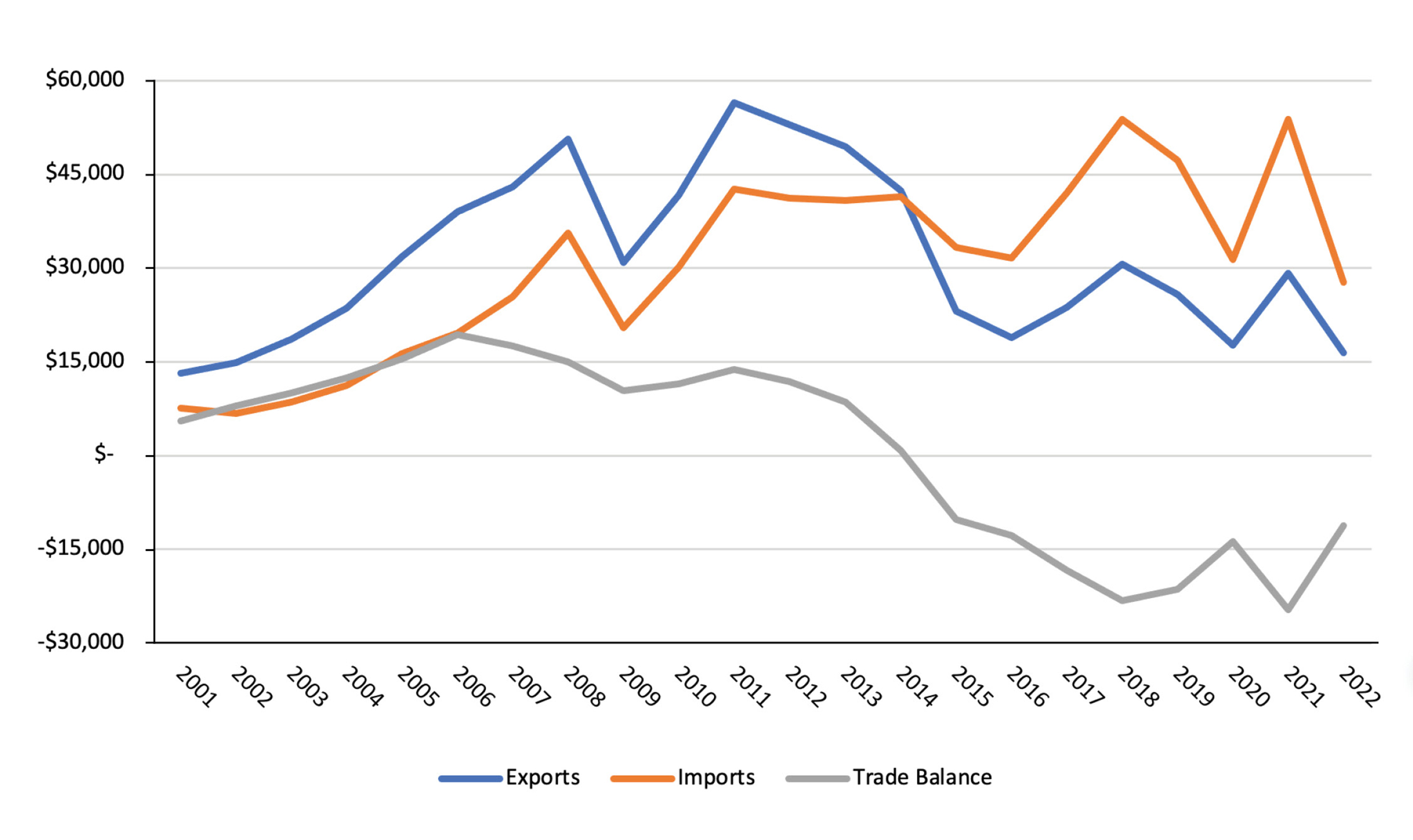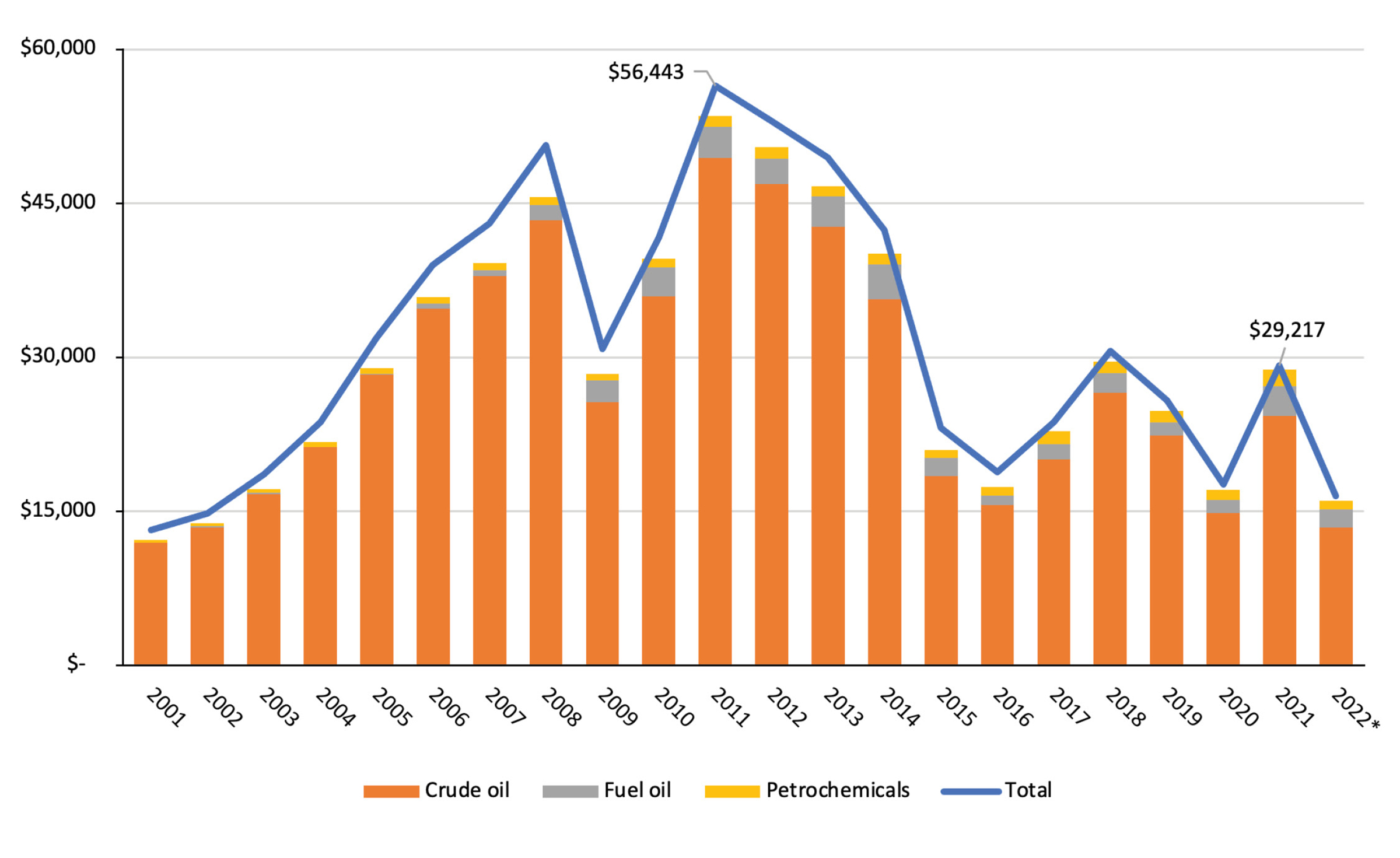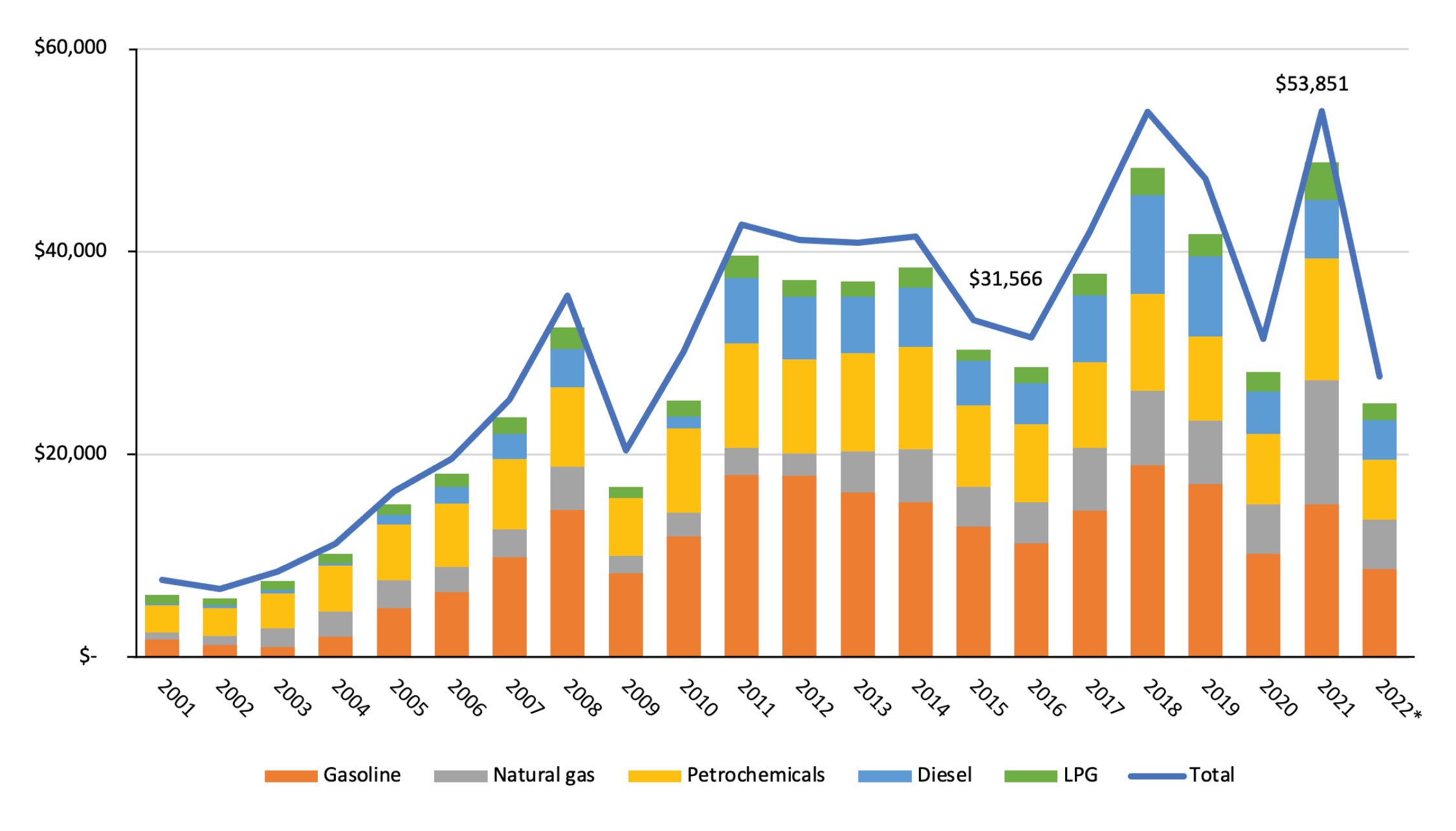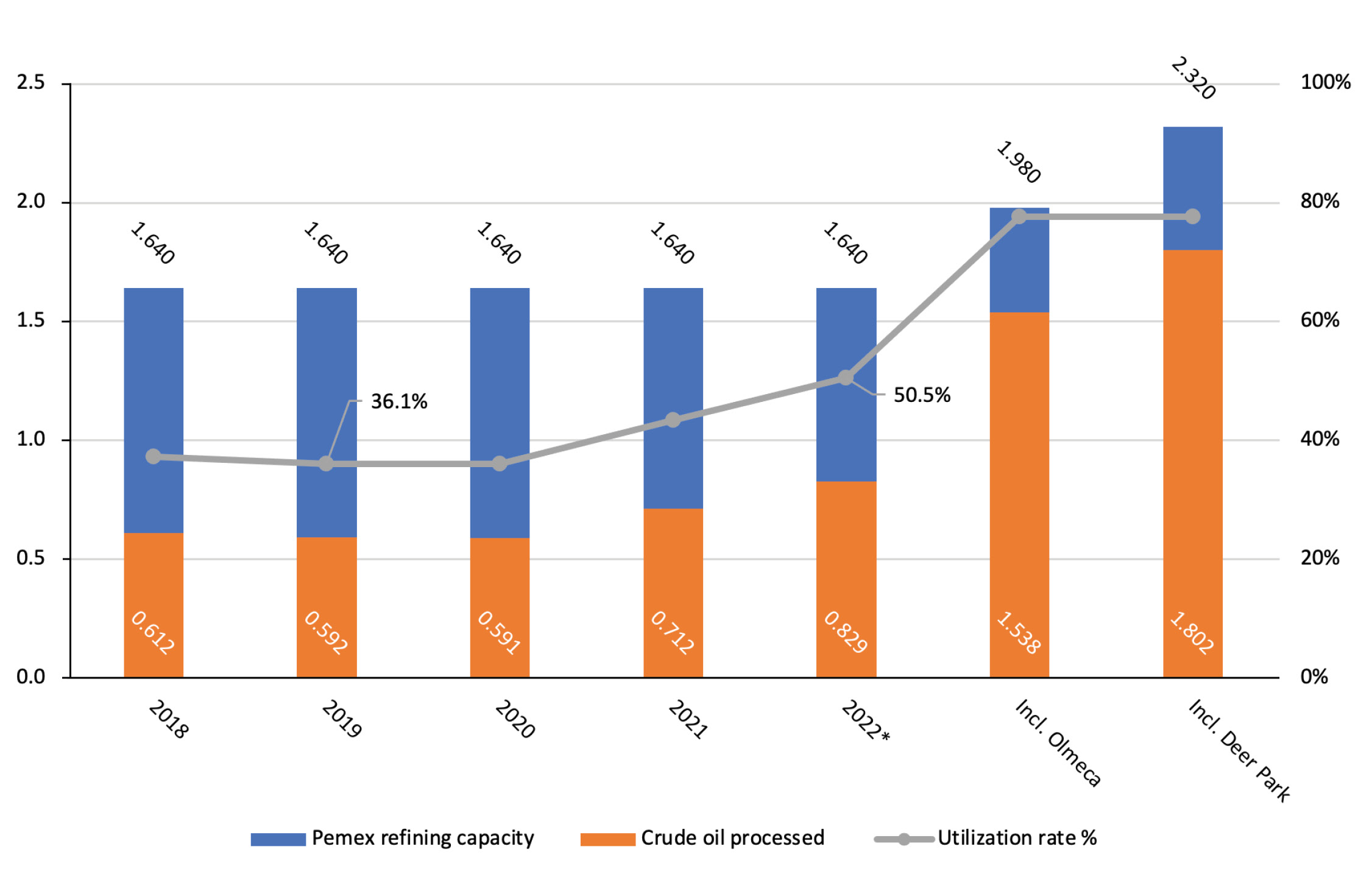Mexico’s Energy Self-sufficiency: A Work in Progress or a Pipe Dream?

Table of Contents
Author(s)
Adrian Duhalt
Former Nonresident Scholar in Mexico Energy StudiesShare this Publication
- Print This Publication
- Cite This Publication Copy Citation
Adrian Duhalt, "Mexico’s Energy Self-sufficiency: A Work in Progress or a Pipe Dream?" (Houston: Rice University’s Baker Institute for Public Policy, August 23, 2022), https://doi.org/10.25613/MCZX-Z792.
Energy security—defined by the International Energy Agency as the “uninterrupted availability of energy sources at affordable prices”[1]—is acknowledged as a critical policy goal for most countries. But in Mexico, where the current government has more nationalistic leanings, energy self-sufficiency sits at the top of the agenda. This concept, a persistent feature in President Andrés Manuel López Obrador’s rhetoric, entails producing all energy, especially all petroleum products, within the country to meet domestic market demand. López Obrador also seeks to cease imports of motor fuels before the end of his presidential term in 2024,[2] and Petróleos Mexicanos (Pemex), Mexico’s national oil and gas company, is viewed as the essential player to accomplish such an undertaking. To that end, López Obrador has put a plan in motion to make Pemex the engine for all of Mexico’s hydrocarbons development.
The government’s plan may seem commendable, since it intends to reverse years of Pemex’s declining production of refined products. However, its emphasis on motor fuels is concerning. While seeking to build up state-owned refinery runs, other major areas of the industry, such as natural gas and petrochemicals, have not been given adequate consideration—at least for the time being. As a share of the country’s total energy imports, together natural gas and petrochemicals rose from 30.9% in 2019 to 44.9% in 2021 (Figure 3), revealing the flawed logic of the administration’s narrow focus on motor fuels.
Given the current situation and the fact that López Obrador is now four years into a six-year term, it is appropriate to shed further light on his plan. Official estimates—measured by the value of trade flows of crude oil, natural gas, and derivatives—signal that Mexico’s energy self-sufficiency in 2021 was in worse shape than in 2019, when López Obrador had just taken office. Indeed, evidence suggests that energy self-sufficiency for Mexico will continue to be an elusive goal for the foreseeable future (Figure 1).[3] Yet, despite the numbers, López Obrador remains confident that the measures implemented in the first half of his tenure, such as the construction of the Olmeca refinery in the state of Tabasco,[4] will render positive outcomes before he leaves office on October 1, 2024. But his optimism must be weighed against the evidence.
A Widening Energy Trade Deficit
Regarding its energy trade balance, Mexico no longer resembles the profile of a producer and exporter of hydrocarbons and petroleum products. Instead, it has the profile of an energy consumer market. First, in every energy commodity in Figure 1—from crude oil and natural gas to fuels and petrochemicals—production levels at Pemex have declined. This, together with robust domestic demand, led Mexico to become a net energy importer beginning in 2015—for the first time in decades.
Numerous factors are at play when it comes to understanding what has shaped Mexico’s energy trade profile. Among energy exports (Figure 2), the case of crude oil stands out. Output decreased from 3.127 million barrels per day (MMbd) in 2001[5] to 1.627 MMbd in January-May 2022.[6] This downward trajectory has halved the country’s capacity to supply crude oil to international markets. The volume of crude oil shipped abroad fell by 47% over the period mentioned above, from 1.755 MMbd to 0.930 MMbd,[7] exacerbating a mounting deficit that has been a stubborn feature of the country’s energy trade outlook in recent years.
Figure 1 — Mexico’s Trade Balance of Hydrocarbons and Petroleum Products, 2001-2022* (in US$ millions)

* January-May
Besides production levels, crude oil prices play an important part in Mexico’s energy profile. As shown in Figures 1 and 2, oil prices are related to fluctuations in the total value of exports.[8] From 2001 to 2008, exports were solidly on the rise as the average price of Pemex crude oil grew from $18.61 to $84.38 per barrel.[9] In 2009, as oil prices plunged to $57.42, so did the value of exports. A similar yet more troubling scenario materialized between 2011 and 2015 when overall exports declined from $56,443 million to $23,100 million,[10] for the most part triggered by crude prices tumbling from $101.13 per barrel to $43.12 per barrel, and production decreasing from 2.552 MMbd to 2.267 MMbd over that period.[11]
For Mexico’s energy trade, 2015 marks the beginning of a chapter that is viewed as the result of years, if not decades, of policies that catered to the financial and political needs of the previous governments, instead of policies designed to endow Pemex with resources to cope with long-term challenges. An outstanding feature associated with these policy priorities, whose effects continue to linger, is that Mexico became anchored to exporting oil, as seen in Figure 2, while (perhaps inadvertently or, as portrayed by López Obrador, deliberately) other strategic activities of the industry such as natural gas, refining, and petrochemicals were left behind. The focus has for a long time been to maximize oil production and revenues. Therefore, Mexico’s current dependency on imports of these commodities (Figure 3) cannot be fully understood without reflecting on the policy decisions of earlier administrations. One stark consequence is that, despite reforms in 2013 and 2014 and all the support that López Obrador’s government has thrown behind Pemex, the energy trade deficit widened from $10,188 million in 2015 to $24,634 million in 2021.
Figure 2 — Exports of Petroleum Products, 2001-2022 (in US$ millions)

* January-May
Figure 3 — Imports of Petroleum Products, 2001-2022 (in US$ millions)

* January-May
While the fate of exports is strongly tied to one single commodity, the strength of imports rests on a larger collection of hydrocarbon-related commodities. In each case presented in Figure 3, falling production compounded by strong demand has resulted in a mounting dependency on imports, which in 2021 registered the highest value in the period analyzed. Besides fuels, such a context is also driven by natural gas and petrochemicals, branches of the hydrocarbon industry that López Obrador—in a similar fashion to his predecessors—paid no notice of during the first three years of his administration.
So, is energy sovereignty weakening as the years go by? Based on estimates from Mexico’s Central Bank shown in Figure 1, this appears to be the case. With the growth of imports outpacing that of exports, the average negative trade balance from 2019 to 2021, the first three years of López Obrador’s term, was 10.4% higher than that of the last three years of the past administration (2016-2018), and 118% higher than the full term of Enrique Peña Nieto (2013-2018). Moreover, the total value of imports of hydrocarbons and refined products was 1.84 times higher than that of exports in 2021, the broadest gap since the beginning of López Obrador’s term.[12]
López Obrador’s Bet on Refining
As mentioned earlier, the notion of energy self-sufficiency is largely centered on upgrading crude oil refining. The rationale for this was explained by López Obrador in his speech[13] at the “inauguration” of the first construction phase of the Pemex-owned Olmeca refinery on July 1, 2022:
In the 36 years of the neoliberal period, a refinery was never built in the country. During this time, the bet was to sell crude oil and purchase gasoline, diesel and other fuels abroad.
The road to self-sufficiency, as conceived by López Obrador, is paved with a collection of refining projects. In addition to building 17 crude oil processing plants in the state of Tabasco as part of the Olmeca refinery, the plan also contemplates two coking units[14] to be assembled at the refineries of Tula and Salina Cruz, the acquisition of the Deer Park refinery in Houston, and ongoing upgrades of the six refineries owned by Pemex.[15]
As for the Olmeca refinery, whose operations could start beyond 2023,[16] it will add 0.340 MMbd to the refining capacity of 1.640 MMbd[17] that Pemex currently boasts, increasing its total crude oil processing capacity to 1.980 MMbd (Figure 4).[18] A question that lingers is if this will be enough to meet domestic demand for motor fuels. The following figures may not correspond to the same period, but the available data concerning production of gasoline allow us to shed light on this question. Throughout its six refineries, Pemex yielded 0.288 MMbd of gasoline[19] at a utilization rate of 50.5% between January and May 2022.[20] And with the Olmeca refinery expected to produce up to 0.170 MMbd at full capacity,[21] Pemex production could—under these assumptions—amount to 0.458 MMbd of gasoline, which represents 61.4% of demand from January to May 2022.[22]
Figure 4 — Pemex Refining Capacity and Crude Oil Processing (in MMbd)

* January-May
Adding Deer Park´s 0.340 MMbd to the above numbers would result in Pemex’s total processing capacity reaching 2.320 MMbd. Likewise, the only refinery owned by Pemex abroad yields roughly 0.110 MMbd of gasoline[23]—a volume that would take Pemex’s overall production to 0.568 MMbd, or 76.24% of Mexico’s needs, as reported in the period of January through May 2022. In this scenario, López Obrador’s self-sufficiency goals, at least for gasoline, are out of reach. However, if the prospective production of the two coking units is considered, as well as upgrades in the utilization rate of Pemex’s current refineries, López Obrador’s goal may be more attainable.
In that regard, consider the following. In 2021, the world’s utilization rate of refineries averaged 77.7%.[24] Based on this rate and a refining capacity of 1.640 MMbd, the volume of crude oil that Pemex processes at its six refineries could total 1.274 MMbd, higher than the 0.712 MMbd refined in 2021.[25] The point is, if Mexico’s government manages to operate its refineries at the world’s average rate, the resulting additional capacity in use (0.562 MMbd) not only would be larger than the (full) capacity of the new refinery (0.340 MMbd), it would also lead to the expanded production of gasoline and other fuels. This would certainly help López Obrador fulfill his pledge to reach self-sufficiency in motor fuels, but at the same time, it would create a complex predicament: The crude oil demand of Pemex refineries would also increase.
López Obrador´s answer to this predicament was also explained in his speech at the “inauguration” of the Olmeca refinery on July 1, 2022:
As per the oil industry, the clear objective is to stop exporting crude oil and process our own hydrocarbon raw materials to be self-sufficient in gasoline and diesel.
Bearing in mind the world´s average utilization rate of 77.7%—to be consistent with the example above—a refining capacity of 1.980 MMbd[26] would require a supply of 1.530 MMbd of crude oil. And when Deer Park[27] is considered, the total refining capacity of Pemex, as revealed earlier, rises to 2.320 MMbd, indicating that the eight refineries of Pemex would demand around 1.802 MMbd of crude oil (Figure 4). Here, it is important to emphasize that Mexico’s crude oil output, as of May 2022, averaged 1.661 MMbd, which falls short of what Pemex would require in the above scenarios.
While levels of crude oil production must be a concern for the present government, and certainly for the next one, López Obrador’s pledge to cease exports and to process all crude oil at Pemex refineries is even more worrying. The implications could be far-reaching. First, it must be considered that, in dollar terms, crude oil comprises the overwhelming majority of energy exports, which are an important source of government income. From 2019 to 2021, of the $72,666 million that Mexico shipped abroad in oil and derivatives, $61,491 million corresponded to crude oil exports, or 84.6% (Figure 2). Likewise, given the dire state of natural gas and petrochemicals production, the other two main components of energy exports, it is clear that Mexico risks broadening its energy trade deficit (Figure 1). A second issue to ponder is the unfortunate financial performance of Pemex Industrial Transformation (refining), whose accumulative negative net return from 2013 to 2021 amounted to $58,440 million.[28] And in spite of all the backing provided by the current administration, the financial profile of the subsidiary keeps deteriorating. In 2021, losses stood at $10,690 million, up from $4,250 million in 2019. These numbers suggest that, internally, the operational inefficiencies that the subsidiary has amassed over years, if not decades, of poor management by past governments live on, and that the existing efforts to enhance refining capacity and utilization rates must be paired with a scheme to address such inefficiencies. Without it, the prospective benefits of today´s upgrading of Pemex’s refining capacity could be easily erased. The thousands of millions of taxpayers’ monies being invested today could well render losses tomorrow.
Final Remarks
All branches of the state-owned hydrocarbon industry are sailing through López Obrador’s term at different speeds. The refining arm of Pemex is the clear frontrunner, mainly because it is subject to investment worth billions of dollars aimed at building Mexico’s self-sufficiency in fuels. However, reaching López Obrador’s goals relies in great measure on the new refinery being (fully) functional and on Pemex’s existing refineries being able to increase their utilization capacity rates. That will surely take time and resources. The cost of the Olmeca refinery stands at $10,200 million as of July 2022, a quantity that is expected to be much higher by the time construction is finalized.[29] López Obrador’s plan to upgrade Pemex’s six refineries in Mexico also deserves attention, not only because of the apparent lack of action to correct inefficiencies, but also because of the degree of allocated financial resources. From 2019 to 2021, Pemex’s refining capital expenditures[30] totaled $1,992 million, which is equivalent to around a fifth of what it has dedicated to the Olmeca refinery and, unpredictably, less than a third of what the preceding government assigned in its first three years (2013-2015). Will López Obrador boost capital expenditures in Pemex’s refining as the culmination of his term approaches? This possibility cannot be discarded if self-sufficiency in fuels is to be accomplished by then.
While strides are likely to be made concerning the production of motor fuels, this may not be the case for natural gas and petrochemicals, whose imports between 2019 and 2021 soared from $6,288 million to $12,282 million and from $8,318 million to $12,029 million, respectively. Both activities are strategic in terms of having a widespread impact on the economy (power generation and manufacturing), but it is evident that they do not convey the same symbolism that refining does. And despite recent government announcements[31] to capitalize both sectors, the prospect of Mexico becoming even more reliant on imports by 2024 is still a reality. As the evidence suggests, López Obrador seems to be repeating the mistakes of his predecessors in the sense that, from a policy standpoint, his focus only includes motor fuels and oil production, leaving aside (at least until now) natural gas and petrochemicals—high-value commodities whose imports are expected to increase going forward. López Obrador’s government must have policies on all these tracks. Without comprehensive policies, achieving energy self-sufficiency (considering crude oil, natural gas, refined products, and petrochemicals) appears to be a long shot.
Endnotes
[1] IEA (International Energy Agency), “Energy security,” https://bit.ly/3olI0BT.
[2] As reported in the stenographic version of President López Obrador's morning press conference on June 29, 2022: https://bit.ly/3cg5ghY.
[3] Figure 1 exhibits Mexico´s energy trade balance of petroleum products as computed by Banxico (Mexico’s Central Bank), which refers to exports and imports of crude oil, natural gas, crude oil derivatives (gasoline, diesel, fuel oil, jet fuel, liquefied petroleum gas, etc.) and petrochemicals. See: Banxico, “Economic Information System, Historical series of petroleum products trade balance,” https://bit.ly/3IHSHIq.
[4] Pemex (Petróleos Mexicanos), “Business Plan 2019-2025,” https://bit.ly/3uTbkTR.
[5] Pemex, “Annual statistical yearbook 2002,” https://bit.ly/3uSDChg.
[6] Monthly average. See CNH (Mexico´s National Hydrocarbons Commission), “National production of hydrocarbons,” May 2022, https://bit.ly/3o8KxPJ.
[7] SIE, (Mexico´s Energy Information System), “Volume of crude oil exports by geographical destination,” https://bit.ly/3Oca0Cy.
[8] This refers to exports of crude oil and petroleum products.
[9] For Pemex’s crude oil weighted average export price, see Petróleos Mexicanos, Annual Reports Submitted to the U.S. Security Exchange Commission, Form 20-F, https://bit.ly/3AZKInW.
[10] 86.04% of overall exports from 2011 to 2015 corresponded to crude oil.
[11] For Mexico´s crude oil production, see: Petróleos Mexicanos, Annual Reports Submitted to the U.S. Security Exchange Commission, Form 20-F, https://bit.ly/3AZKInW.
[12] Banxico, “Economic Information System, Historical series of petroleum products trade balance,” https://bit.ly/3IHSHIq.
[13] Gobierno de México, “Inauguración de la Refinería Dos Bocas. 4° Año del Triunfo Histórico,” streamed live on July 1, 2022, YouTube video, 3:06:17, https://bit.ly/3RMO4kd.
[14] Coking is a refinery unit operation that receives residues coming from the distillation process and transforms them into higher value products. See U.S. EIA (Energy Information Administration), “Coking is a refinery process that produces 19% of finished petroleum product exports,” January 28, 2013, https://bit.ly/3aZKT8j. The coking unit at Tula, in the state of Hidalgo, is expected to be operating in December 2023. See: Andrés Manuel López Obrador (@lopezobrador_), “Coking Plant in Tula, Hidalgo,” Twitter video, March 26, 2022, https://bit.ly/3B97M3W. The construction of the coking unit at Salina Cruz, in the state of Oaxaca, is expected to be completed in August 2024.
[15] For López Obrador’s plan on crude oil refining see Gobierno de México, “Inauguración de la Refinería Dos Bocas. 4° Año del Triunfo Histórico,” streamed live on July 1, 2022, YouTube video, 3:06:17, https://bit.ly/3RMO4kd.
[16] López Obrador suggests that the Olmeca refinery will be operating fully in 2023, but industry pundits argue that operations are more likely to begin in 2024. See Kylie Madry and Ana Isabel Martínez, “Mexico president says new Pemex refinery will reach full capacity in 2023,” Reuters, June 15, 2022, https://reut.rs/3Q5F2gP.
[17] As of 2021. See Pemex, 2021 Annual Report Submitted to the U.S. Security Exchange Commission, Form 20-F, https://bit.ly/3PvUin3.
[18] These numbers do not include Deer Park. In Mexico, Pemex processed 0.829 MMbd of crude oil between January and May 2022. See Pemex Institutional Database, “Production of refined products,” https://bit.ly/3RTlVrJ.
[19] Pemex Institutional Database, “Production of refined products.”
[20] Pemex Institutional Database, "Crude oil processed 2013-2022," https://bit.ly/3z0ZcBn.
[21] Secretaría de Energía, “La refinería de Dos Bocas hoy hace historia y se suma al Sistema Nacional de Refinación para asegurar la autosuficiencia energética,” Press release No. 11, July 1, 2022, https://bit.ly/3OBG6rC.
[22] Gasoline demand in the first five months of 2022 averaged 0.745 MMbd. See Secretaría de Energía, “Estadísticas de petrolíferos, demanda de gasolina,” https://bit.ly/3RXMkog.
[23] Pemex, “Concreta Pemex la adquisición de la refinería Deer Park en EU,” Press release No. 6, January 20, 2022, https://bit.ly/3vaotrU.
[24] BP Statistical Review of World Energy 2022, “Oil refinery throughput and capacity,” https://on.bp.com/3omIEyY.
[25] Pemex Institutional Database, "Crude oil processed 2013-2022."
[26] This includes the existing six refineries of Pemex and the Olmeca refinery.
[27] However, Deer Park´s utilization rate is usually above 80%, as reported by Pemex. See Pemex, “Concreta Pemex la adquisición de la refinería Deer Park en EU.”
[28] Values are converted from MX$ to US$ using the exchange rate of each year provided by Pemex in its 20-F form. See IMCO (Instituto Mexicano para la Competitividad), “Refinería de Dos Bocas: ¿Hacia un sector energético más competitivo?” June 29, 2022, https://bit.ly/3IXEO94; Pemex, Annual Reports Submitted to the U.S. Security Exchange Commission, Form 20-F, https://bit.ly/3RXBAq0.
[29] Secretaría de Energía, “La refinería de Dos Bocas hoy hace historia y se suma al Sistema Nacional de Refinación para asegurar la autosuficiencia energética.”
[30] Pemex, Annual Reports Submitted to the U.S. Security Exchange Commission, Form 20-F, https://bit.ly/3RXBAq0.
[31] Mexico intends to upgrade Pemex ammonia and fertilizer production, as reported in the stenographic version of President López Obrador's morning press conference on July 20, 2022: https://bit.ly/3cGODw3. Pemex plans to invest in deep-water gas projects. See Karol García, “Pemex sí va por gas en aguas profundas,” El Economista, July 4, 2022, https://bit.ly/3ospt6L.
This material may be quoted or reproduced without prior permission, provided appropriate credit is given to the author and Rice University’s Baker Institute for Public Policy. The views expressed herein are those of the individual author(s), and do not necessarily represent the views of Rice University’s Baker Institute for Public Policy.


